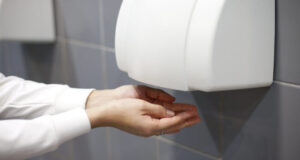
Experts warn that automatic hand dryers, despite their convenience, can be a source of bacteria and germs. Studies show that the hot air blown by dryers can draw germs from the air in restrooms and spray them around—onto hands, surfaces, and into the room itself.
In one experiment cited by the Harvard Medical Portal, Petri dishes placed under a working dryer for 30 seconds showed growth of up to 254 bacterial colonies, while control dishes exposed only to the air in the restroom without a dryer showed only one colony.
When researchers installed HEPA filters on the dryers, the number of bacteria decreased by 75%, suggesting that a significant portion of the contamination comes from the indoor air rather than from the internal parts of the device.
Another study, published in the journal Aerosols and Bacteria From Hand Washing and Drying in Indoor Air, compared dryers with paper towels. The results: aerosol and bacteria concentrations after drying hands indoors increase regardless of the method used — dryers or towels.
Another study, Assessment of the bacterial contamination of hand air dryers, showed that dryers produce more “ballistic droplets” that travel further into the room and may contain skin microbes. The authors note that in some cases, dryers can deposit pathogenic bacteria on users’ hands and clothing, especially if the device is located close to the sink or when the air humidity is high.
In addition, the American publication “Automatic Hand Dryers Can Be a Source of Microbial Contamination” states that the internal parts of dryers — the body and nozzles — may contain staphylococci and coliform bacteria. When the device is turned on, these microbes can be transferred to the user’s hands. According to researchers’ estimates, in men’s and women’s restrooms, the internal surfaces of dryers contain an average of 300 microorganisms per 5 cm² in the lower part of the body.

Scientists at the Chinese Academy of Sciences have discovered nearly 1,000 species of bacteria in snow and ice samples collected from Tibetan glaciers, Phys.org reports.
Ice sheets and glaciers cover approximately 10% of the Earth’s surface and also serve as the largest reservoir of fresh water.
Scientists collected snow and ice samples from 21 glaciers in Tibet in 2010-2016, melted them down and tested them to see what was left in the water.
“In doing so, the researchers found 968 unique bacterial species, 98% of which have never been seen before. The results come following a study by another team that recently discovered several viruses in 15,000-year-old ice, most of which have never been seen before. “, the message says.
According to scientists, some of these bacteria and viruses can be infectious for animals and humans, and as snow and ice melt due to climate change, they can get into rivers and streams in populated areas with water.
“And perhaps even more of a problem may be that modern plants and animals, including humans, are not immune to old microbes, which suggests they can be deadly and difficult to treat. Thus, they represent the possibility of local epidemics.” and possibly pandemics.
The researchers note that the bacteria they studied came from a particularly important part of the world – melting snow and ice in Tibet feeds several rivers that lead to densely populated areas in China and India.
In this regard, experts propose to immediately begin work on the study of microbes that can spread from glaciers around the world.